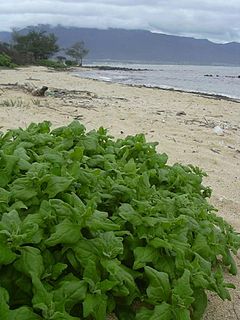
Tetragonia is a genus of about 85 species of flowering plants in the family Aizoaceae, native to temperate and subtropical regions mostly of the Southern Hemisphere, in New Zealand, Australia, southern Africa and South America.

Leucophyta is a plant genus which is endemic to Australia. The genus was first formally described by botanist Robert Brown in 1818.
Conospermum acerosum, commonly known as needle-leaved smokebush, is a shrub endemic to Western Australia
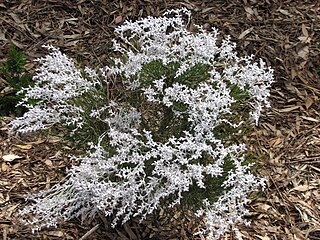
Conospermum stoechadis, commonly known as common smokebush, is a shrub endemic to Western Australia.

Hibiscus diversifolius, the swamp hibiscus, is a widespread species of hibiscus. It grows to between 1 and 2 metres in height, with prickly stems and yellow flowers with a maroon basal spot during spring summer.

Carpobrotus virescens, commonly known as coastal pigface, is a prostrate coastal succulent shrub of the family Aizoaceae native to Western Australia. The Noongar peoples know the plant as Kolbogo or Metjarak.
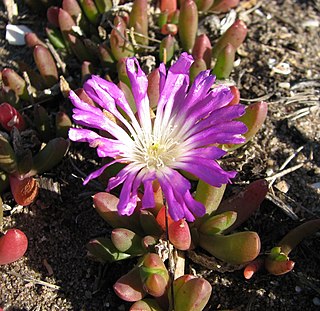
Disphyma crassifolium subsp. clavellatum is the subspecies of Disphyma crassifolium that occurs in Australia and New Zealand. It is sometimes known by the common name rounded noon-flower

Sesuvium portulacastrum is a sprawling perennial herb that grows in coastal areas throughout much of the world. It is commonly known as shoreline purslane or (ambiguously) "sea purslane," in English, dampalit in Tagalog and 海马齿sl in chinese.
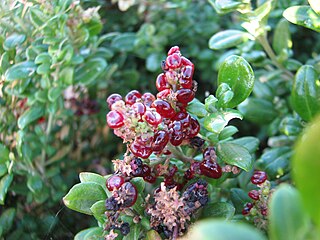
Chenopodium candolleanum, commonly known as seaberry saltbush, is a shrub in the subfamily Chenopodioideae of the family Amaranthaceae, native to Australia.
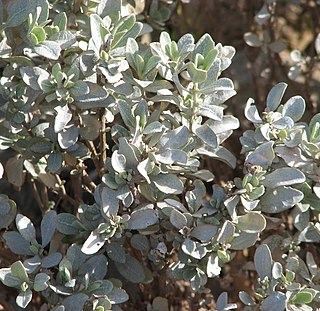
Atriplex vesicaria, commonly known as bladder saltbush, is a species of saltbush endemic to Australia.
Atriplex vesicaria subsp. variabilis is subspecies of bladder saltbush endemic to Australia.

Sporobolus virginicus, known by numerous common names including seashore dropseed, marine couch, sand couch, salt couch grass, saltwater couch, coastal rat-tail grass, and nioaka, is a species of grass with a wide distribution.

Melilotus indicus, sometimes incorrectly written Melilotus indica, is a yellow-flowered herb native to northern Africa, Europe and Asia, but naturalized throughout the rest of the world.
Nicotiana occidentalis, commonly known as native tobacco, is a short-lived herb native to Australia.

Astartea fascicularis is a species of flowering plant in the myrtle family, Myrtaceae. It is endemic to southwestern Western Australia, where it is widespread in the Recherche Archipelago and present on the mainland in Cape Le Grand National Park. It is commonly known as Recherche astartea. or false baeckea.

Galenia pubescens is a low-growing perennial herb in the family Aizoaceae. It is native to southern Africa and naturalised elsewhere.
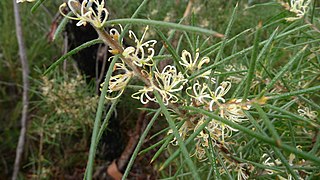
Hakea gibbosa, commonly known as hairy hakea or needlebush hakea, is a shrub of the family Proteaceae, and is endemic to south eastern Australia. It has very prickly foliage, cream-yellowish flowers from April to July, and provides shelter for small birds. It has become an environmental weed in South Africa and New Zealand, where it had been introduced for use as a hedge plant.
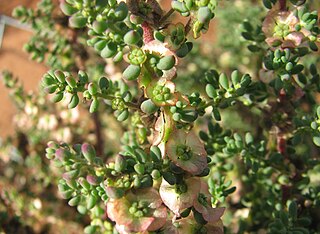
Maireana brevifolia is a shrub that is native to Australia and naturalised in South Africa, the Middle East and the Canary Islands. Common names in Australia include cotton bush, eastern cotton-bush, short-leaf bluebush, small-leaf bluebush and yanga bush. It grows to between 0.2 and 1 metre high. The flower-like fruits are up to 9 mm in diameter and comprise 5 paper-thin wings. It is one of the first species to appear in disturbed saline habitats.

Fumaria capreolata, the white ramping fumitory, is an herbaceous annual plant in the poppy family Papaveraceae. It is native to Europe, western Asia and northern Africa and naturalised in southern Australia, New Zealand, and southern South America. Common names include climbing fumitory, ramping fumitory, white fumitory, white ramping fumitory and white-flower fumitory.
Tetragonia nigrescens is a plant native to southern Africa.

















